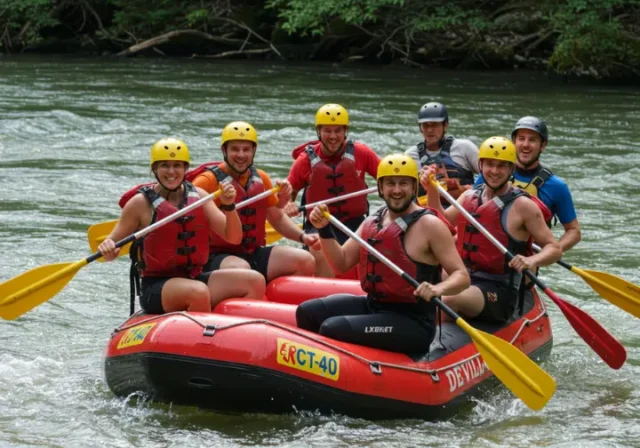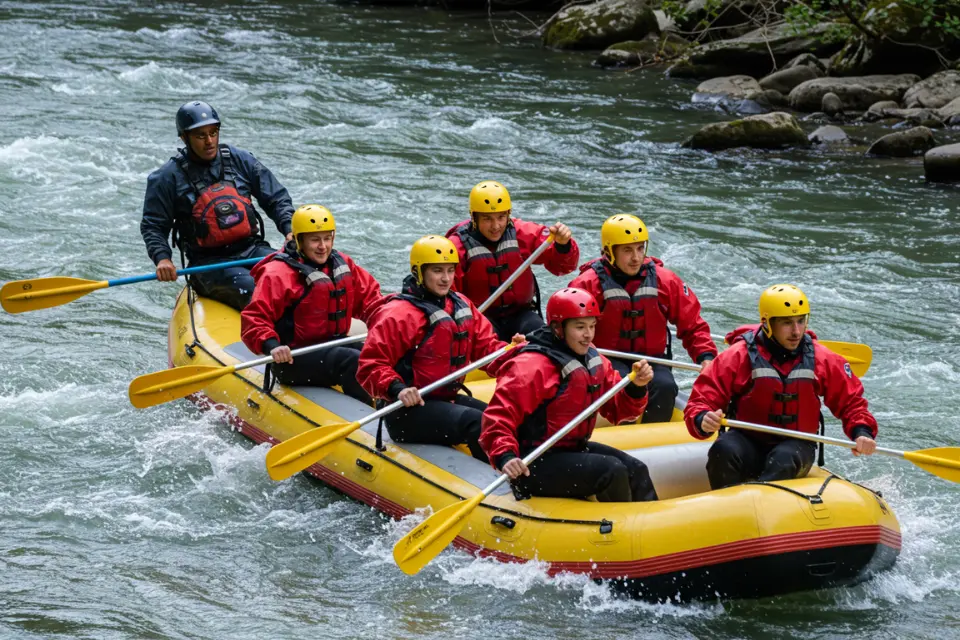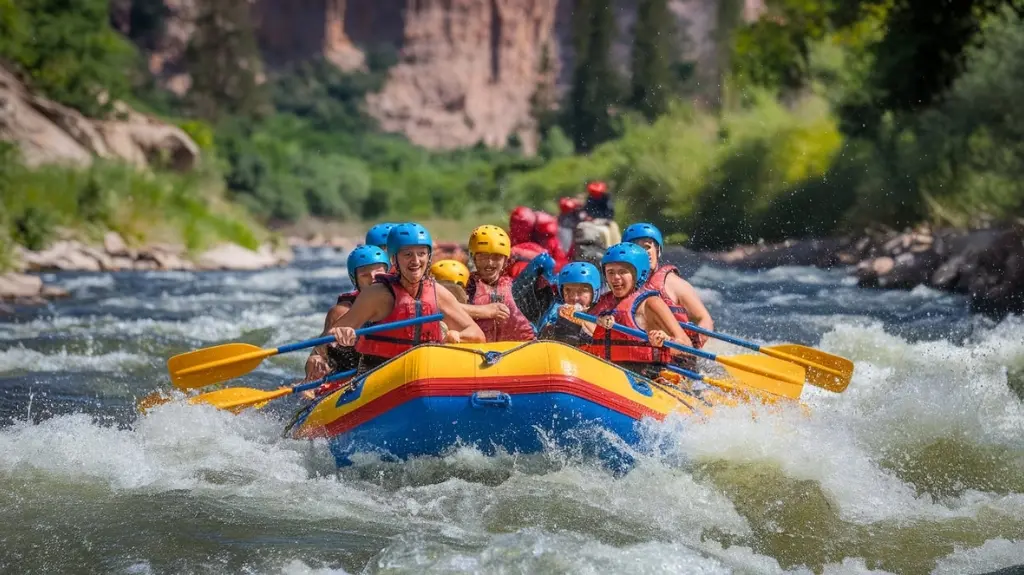In this article
Dress right, and you will conquer any rapid! Layer up with quick-drying synthetics or merino wool; avoid cotton. Knowing what to wear for rafting is key to success. Secure sandals or water shoes are vital; ditch the flip-flops. A PFD is mandatory. Don’t forget sunglasses with a retainer, sunscreen, and a waterproof bag. Seasonal changes mean wetsuits or drysuits. You will stay warm with neoprene in cold water. Your rafting experience will stay safe and epic. There’s a reason old-timers say, “Be prepared.” Details will give you the edge in grasping the river’s challenges.
River Ready: Dressing for Success on Your Rafting Adventure
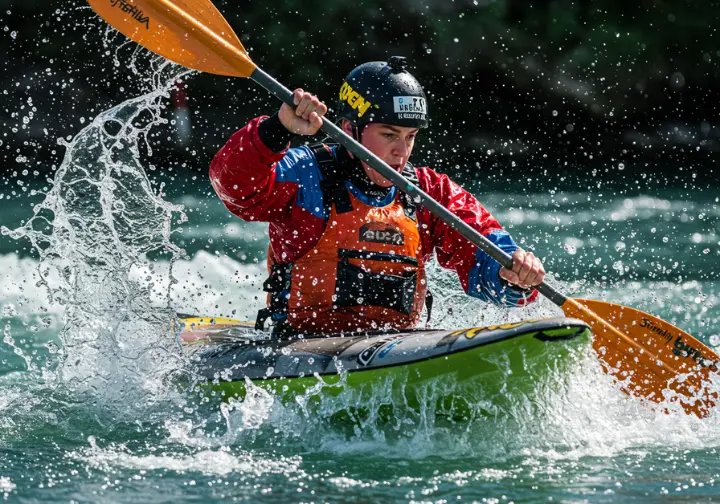
The thrill of whitewater rafting is undeniable, but if you’re not prepped with the right gear, you could be trading adrenaline for discomfort.
First, think about your base layer. A swimsuit is a great start. You’ll additionally want quick-dry clothing, as there’s no avoiding the water! Polyester and nylon are excellent material selections for their moisture-wicking capabilities.
Your personal flotation device (PFD) is mandatory. We always say, “no PFD, no paddle”.
Footwear is next. Ditch the flip-flops and opt for sturdy water shoes. They’ll protect your feet and keep you secure steering slippery rocks.
If the water is cold, a wetsuit is crucial. Finally, protect your valuables. A dry bag will keep your phone, wallet, and extra clothes safe and dry during your rafting adventure. In this manner you can make sure you’d an unforgettable experience when whitewater rafting!
Seasonal Strategies: Adapting Your Rafting Gear to the Elements
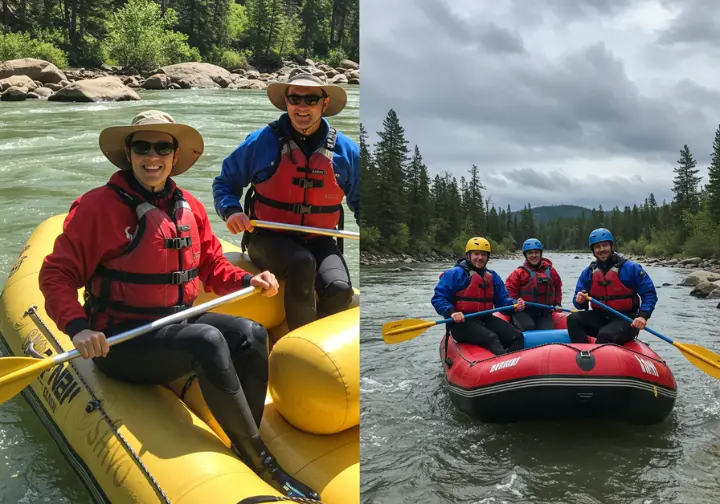
You’ll need a different approach as the seasons change to stay comfortable and safe! We’re going to explore the right gear for summer heat, shoulder-season chill, and even winter’s icy grip. Remember the importance of selecting quick-drying fabrics, like synthetics, for optimal comfort and protection during your rafting adventure. Let’s get you ready for rafting, no matter the weather.
Summer Essentials
Summer rafting demands gear which keeps you cool, dry, and shielded from the sun’s intensity.
Begin with a light, moisture-wicking base layer, bear in mind to avoid cotton clothing, synthetics work best. Quick-dry shirts and shorts are paramount, long sleeves add protection; swimsuit/trunks or quick-drying pants are too great. Athletic-fit shorts are an ideal choice for comfort and flexibility.
Bear in mind sun protection; the water intensifies the sun’s rays! Don’t forget to secure footwear.
Here’s your summer essentials checklist:
- Quick-dry shirts and shorts.
- Sunscreen, sunglasses, and a hat.
- Secure footwear: sandals with straps or water shoes.
- Light, moisture-wicking base layer.
We’re a team out there. Protect yourself, prepare for the sun, and respect the river. Gear up to focus on the thrill of traversing the water!
Spring/Fall Considerations
As water grows colder in spring and fall, thermal protection becomes paramount for a comfortable and safe rafting experience. You’ll want to think about wetsuits or dry suits; recall, in cold water, staying warm is key. Wetsuits work by trapping warmed water against your skin, whereas dry suits keep you completely dry.
Don’t underestimate layering! Fleece or wool under a waterproof jacket is your best bet when layering. A quick-drying layer is vital. Neoprene socks or booties are vital for keeping your feet warm. Good seals and zippers are crucial for preventing water entry in a drysuit.
Winter Rafting (For the Brave)
If you’re brave enough to tackle winter rafting, guarantee you’re seriously prepared for the cold. A high-quality dry suit is key; it’s non-negotiable for staying warm and dry in chilly water. Assure the dry suit has tight seals at the neck and wrists to prevent water entry. Layering is additionally crucial for winter rafting. You may find that a drysuit is more restrictive than another option.
- Wool socks keep your feet warm.
- Long underwear/tights offer insulation.
- Fleece jacket adds warmth to your core.
- Wetsuit boots are key for chilly water.
Don’t omit neoprene gloves and headwear to protect your extremities. Recall, neoprene gloves provide insulation even when wet, and appropriate headwear helps retain body heat.
You’ll need waterproof gear for staying warm, dry, and safe. Always prioritize teamwork for safety on any winter rafting adventure!
The Fabric Factor: Choosing the Right Materials for Comfort and Safety
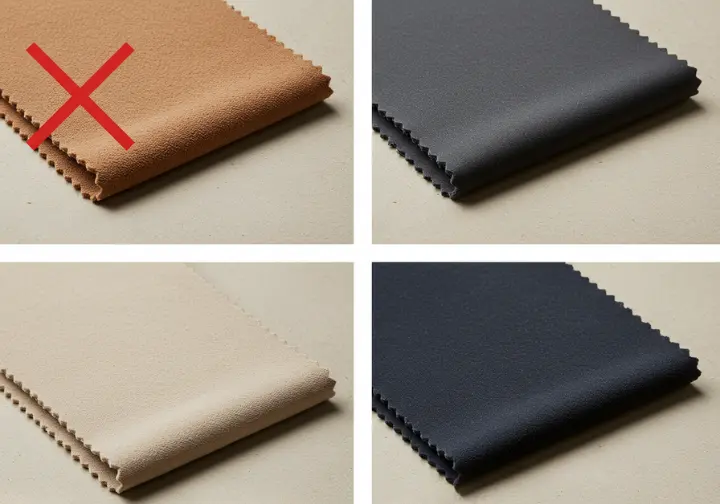
You’re gonna be wet, so what your clothes are made of matters big time on the river. We need to talk about the fabric factor and how it impacts your comfort and safety. Let’s break down the best—and worst—materials for rafting.
The Evils of Cotton: Why You Should Avoid It at All Costs
Cotton is one of the worst fabrics you can wear when rafting. When cotton gets wet, it compromises your safety on the river.
If you’re going on a rafting adventure don’t include cotton items within your clothing, as the wet clothing clings to your skin. It dramatically increases the risk of hypothermia, especially in cold river water.
Here are key reasons to avoid cotton:
- It loses its insulation properties when wet.
- Cotton clothing prolongs discomfort.
- It increases hypothermia risk.
- Avoid cotton fabric use in cold water adventures.
Cotton takes ages to dry, leaving you miserable; it will work against you in the rapids.
Choose synthetic clothing to keep you comfortable and safe during your white water adventure. Don’t let wet clothes be the reason for being taken out of the river. Synthetic clothing will provide a safer, more enjoyable and warm experience.
Synthetics: Polyester, Nylon, and Blends for Quick-Drying Performance
Since staying dry and comfortable on the river is key, synthetics such as polyester, nylon, and their blends are the go-to fabrics every rafter trusts for performance. You’ll find how synthetic clothes, like a water shirt, excel since they’re quick-drying. Polyester and nylon don’t hold water like cotton.
These fabrics are additionally astounding at moisture-wicking, drawing sweat away from your skin, so you stay dry.
You’ll love how lightweight and breathable they feel, keeping you cool when the sun’s blazing. Plus, these materials are durable; nylon and polyester can handle the splashes and scrapes of a wild ride better than other fabrics. Look for blends in your gear to get the best performance. You won’t regret ditching this old cotton tee for synthetics.
Wool: Merino Wool for Warmth, Even When Wet
As synthetics set the standard for quick-drying performance, warmth when wet is where wool shines; we should examine merino wool‘s benefits on the river. It’s a stellar choice, particularly in cooler conditions, since wool retains its insulating abilities even when wet. You’ll find it a lifesaver when temperatures plummet during your rafting trip.
Merino wool is additionally highly moisture-wicking, regulating your body temperature.
Plus, it’s naturally odor-resistant, a huge benefit for multi-day river clothes. Think about packing merino wool long underwear and socks. You’ll value the comfort and performance, and it keeps you fresh. Here’s why wool rocks:
- Exceptional warmth
- Moisture-wicking properties
- Odor-resistant qualities
- Softness against the skin.
You’ll stay comfortable throughout your rafting trip.
Neoprene: Providing Insulation in Wetsuits and Booties
For cold-water rafting, neoprene provides excellent thermal insulation, finding its way into wetsuits, booties, gloves, and headwear. That synthetic rubber traps a thin layer of water. You warm it, creating a barrier against the cold. Neoprene’s flexibility allows a full range of motion, paramount for paddling.
You’ll find neoprene in everything from a full wet suit to wetsuit booties. It provides water resistance, keeping you warmer when splashed.
We use neoprene extensively in cold water rafting, especially when constant immersion is expected. Think of neoprene gloves preserving dexterity.
It’s not fully waterproof, but its balance of thermal insulation, flexibility, and water resistance makes neoprene a solid choice. We’re talking comfort and safety out there.
Footwear Fundamentals: Selecting the Best Shoes for Whitewater Rafting
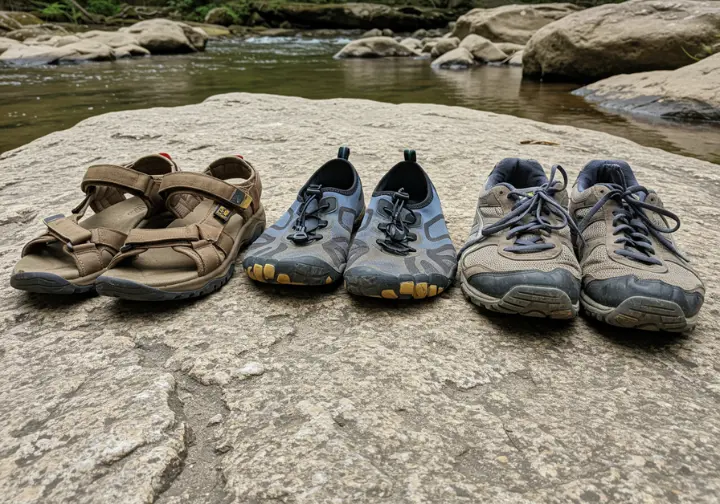
You’ll need the right footwear to keep your feet protected and planted through every paddle stroke.
We should examine the critical gear—secured sandals, water shoes, and even old sneakers—that can make or break your grip. We’ll too chat about why you shouldn’t even consider flip-flops for rafting.
Secured Sandals: Tevas, Chacos, or Similar Strapped Sandals
Tevas, Chacos, and similar strapped sandals aren’t just footwear; they’re your trusty sidekicks for journeying across slick rocks and roaring rapids. These river sandals are popular for rafting because they offer a secure fit and versatility.
The straps keep your sandal on your feet, even when you’re traversing intense sections of river. Adjustable straps mean you can customize the fit, adding comfort and security.
When choosing your water sandals, keep these points in mind:
- Secure fit: the sandal’s straps must keep your feet safe!
- Comfort: you’re on your feet most of the day
- Versatility: you’re additionally hiking around the campsite
- Traction: crucial for traversing the slick rocks
Look for sandals with non-slip soles to give you good traction on wet surfaces. These amphibious shoes can be worn in and out of the water. They’re frequently because useful for hiking.
Water Shoes: Offering Protection and Grip
Strapped river sandals offer security and are versatile, but they don’t offer complete protection. This is where water shoes come in. They’re an excellent choice when you need full foot protection with this reliable grip.
These gems cover your entire foot, shielding it from rocks, debris, and sharp objects – if you’re in the rafts or traversing riverbeds.
Look for sturdy footwear with specialized soles; they’ll give you excellent traction, so you won’t be slipping on wet rocks. They’re made from quick-drying materials, so you won’t be lugging around waterlogged shoes either. Wear them with aquasocks for extra comfort. Select the right water shoes and you’ll soon find this they’re your best friends on all your future rafting adventures even with swim shorts.
Old Athletic Shoes: A Decent Alternative, but Be Prepared for Them to Stay Wet
If you’re seeking a budget-friendly footwear solution for rafting, old athletic shoes present a viable alternative, but it’s vital to understand their limitations. For those asking, “what to wear rafting?”, you’ll find they offer some protection compared to bare feet, shielding you from rocks. You don’t have to spend extra if you already have a pair.
Nonetheless, you must consider a few things regarding your complete outfit.
But before you decide, consider these factors:
- They can become waterlogged.
- They might cause blisters.
- They may not have the best traction.
- They may weigh you down.
When choosing your rafting attire, bear in mind athletic shoes will stay wet. They’re heavy and traction isn’t as solid as water shoes. Secure shoe laces tight.
Although convenient, bear in mind they’re a tradeoff. If you don’t have money for water shoes or other watersports gear, they’ll do. When rafting, the most important is safety, no matter what bottoms or shoes someone might wear!
Why Flip-Flops Are a No-Go: Safety Hazards and Lack of Support
Even though they might seem convenient, flip-flops are the absolute worst choice for whitewater rafting, posing a significant safety hazard, as they easily slip off your feet in the water, where losing your footwear can lead to injuries. They offer no protection, leaving you vulnerable to cuts and scrapes.
Envision traversing the rapids; flip-flops won’t stay put!
The lack of traction increases your risk of slipping around the raft or along the riverbank. They’re not designed for the physical demands of rafting and aren’t vital safety equipment. Securing your water shoes is paramount. Consider water shoes with laces/straps for better traction and a snug fit.
Don’t let unsecured footwear ruin your rafting experience. Recall, teamwork and safety go hand-in-hand on any floatation device.
Essential Accessories: Completing Your Rafting Ensemble
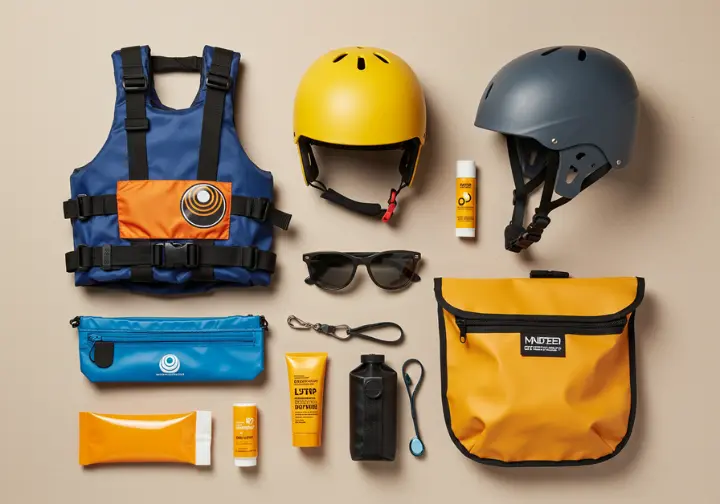
You’re almost ready to hit the river, but don’t forget those vital extras which can make or break your trip! We need to talk about necessary accessories like PFDs, helmets, and how to protect yourself from the sun and water.
Let’s get right into how these items enhance safety and comfort on the water.
Personal Flotation Device (PFD): A Non-Negotiable Safety Item
A personal flotation device (PFD), furthermore known as a life jacket, is the most vital piece of safety gear for whitewater rafting. The PFD, or life jacket guarantees your buoyancy in the water, keeping you afloat if you unexpectedly exit the raft.
Guarantee your PFD fits snugly, yet comfortably; it shouldn’t ride up when you’re submerged. It’s often mandatory on commercial rafting trips.
Here’s what you need to know:
- Buoyancy: It floats you!
- Fit: Snug is safe.
- US Coast Guard Approved: Look for the approval, and the outfitter will guarantee your PFD meets safety standards.
- Mandatory: Most trips will require wearing a PFD.
Always wear a PFD which is US Coast Guard Approved. Most rafting trips will make wearing a PFD at all times mandatory.
It’s a vital safety measure which can save your life, so don’t take floats in a raft without one.
Helmet: Protecting Your Head in Case of Falls
Head injuries are a real concern in whitewater rafting, since you’re going over rocks and other objects in the water, and that is where a helmet comes in. The impact protection these provide is vital for your safety. You’ll want a rafting-specific helmet—a paddling helmet is a must. Make sure you’ve got good impact protection, and don’t forget about those adjustable straps. They’re integral for getting a snug fit. You wouldn’t want it sliding around, especially in loud rapids or on your personal rafting trips. The retention strap—one, tube, small tube—keeps it secure.
Sunglasses with Retainer Strap: Shielding Your Eyes from the Sun and Preventing Loss
Since rivers can “eat sunglasses like crazy”, sunglasses are indispensable for shielding your eyes from harmful UV rays and reducing glare from the water, which can improve your visibility and comfort.
Prolonged exposure to UV rays can cause eye damage, so protect your eyes. A retainer strap is crucial for keeping your sunglasses secure during water rafting or as you swim, and prevents them from being lost.
When considering what to wear to rafting, don’t forget these:
- UV protection is always the most important factor.
- Glare reduction will massively increase your visibility.
- A high quality sunglasses strap will drastically improve your chances of keeping up with the shades,.
- Polarized lenses can enhance clarity and reduce glare.
If you’re involved in white water rafting what to wear matters so invest in high quality sunglasses and a retainer strap.
Sunscreen and Lip Balm: Protecting Your Skin from Harmful UV Rays
Don’t underestimate the sun, even on overcast days; beyond your shades protecting your eyes, you’ve gotta shield your skin. We all know how intense the sun’s harmful UV rays can be, especially reflecting off the river.
That’s why sunscreen and lip balm are non-negotiable. Use a broad-spectrum sunscreen with a high SPF; it’ll defend against both UVA and UVB rays. Grab a water-resistant formula to keep it effective when you’re wet.
Recall reapplication. This is key, particularly after swimming or sweating; don’t skimp!
And your lips? They’re just as vulnerable. A lip balm with SPF is your best bet. Protecting your skin guarantees you’re comfortable so you can focus on teamwork and adrenaline.
Waterproof Bag: Keeping Valuables Safe and Dry
Every rafter knows the importance of keeping prized possessions safe and that’s where a waterproof bag becomes your best ally, shielding your key belongings from splashes and accidental dunkings. No one wants a waterlogged phone!
A dry bag lets you enjoy the river without worry, ensuring your essentials stay dry even during unexpected submersion.
Here’s what to look for in a waterproof bag for your next trip:
- Ensure the waterproof bag is large enough for your phone, camera, and any extra layers you’re bringing.
- A roll-top offers a great closure; you need a secure closure to prevent leaks.
- Attachment points on the bag let you secure it, so it doesn’t go overboard.
- Think about how the bags you choose performs when submerged.
An approved waterproof case offers similar protection for smaller valuables. By investing in a quality waterproof bag, you’re safeguarding your prized possessions.
Whistle: For Emergencies
A whistle isn’t just a piece of plastic; it’s your voice on the river when words fail. It’s an effective signaling device when you need to signal for help during emergencies. Every rafter knows the value of a loud noise to cut through the roar of the rapids. Where your whistle comes in, a small but mighty tool for communication.
Keep your whistle attached to your PFD since it needs to be readily accessible.
In the chaos of rafting, especially tackling those adrenaline-pumping rapids, verbal communication is difficult. A blast from your whistle is a clear, unmistakable call for help. Don’t underestimate it. A whistle can be your lifeline, helping to keep everyone safe on the water. Make sure it’s part of your rafting necessities. The signaling device might save someone’s life.
Expert Tips and Tricks: Enhancing Your Rafting Experience
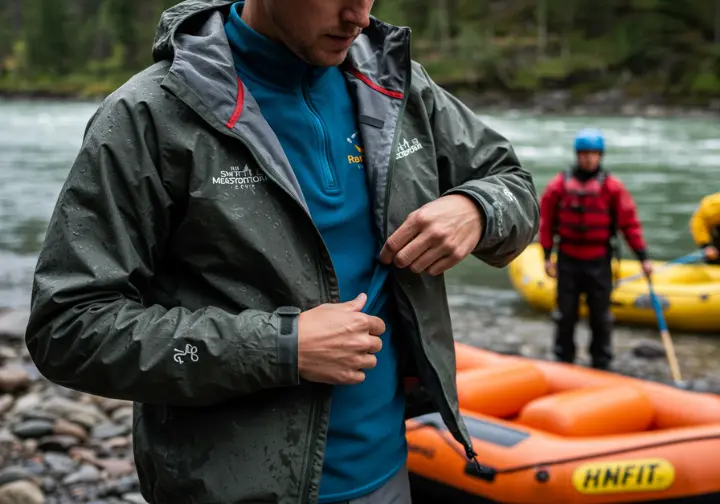
Ready to up your rafting game? You’ll find your time on the water way more enjoyable if you master a few simple tricks we’ve learned over the years.
Read on for insider info about layering, knowing your outfitter’s gear, and dressing smart!
Layering Like a Pro: Adjusting Your Clothing to Changing Conditions
Since conditions on the river can change quickly, layering your clothing is key to comfort. Layering gives you the flexibility you need to adapt. You can add or remove layers, as required.
Start with a moisture-wicking base layer, like synthetic tights, to keep sweat away from your skin. Add an insulating layer, like fleece, or wool fabric, for warmth. Top it off with a waterproof shell, such as a paddle jacket, to protect against rain and wind.
Here’s how it works:
- Base Layer
- Insulating layer
- Waterproof, windproof outer layer
- Adjust as needed
Layering is a fundamental strategy. As the day warms up, remove layers to prevent overheating. If conditions change, add them back.
Don’t underestimate the importance of staying dry and comfortable; layering’s your best bet.
Checking with Your Outfitter: Knowing What Gear is Provided
To guarantee you’re not carrying unnecessary weight, it’s a smart move to check with your outfitter about the specifics of what they provide. Outfitters often supply fundamental gear: PFD’s, helmets and a paddle. Depending on location and time of year, some may provide a wetsuit or splash jacket which influences what to wear when white water rafting.
Before your trip, confirming what gear acts as the outfitter’s kit, will help you pack only what you need.
Don’t assume; commercial paddling advice always includes clarifying your *outfitter’s* gear plan!
If you’re missing fundamental pieces for your own gear, ask about rental options. Grasping what gear *they* provide means less weight for *you* and avoids those last-minute, overpriced purchases.
Considering Water Temperature: Dressing for the Water, Not the Air
Regarding, you’ve gotta recall the river doesn’t care about that sunshine beaming down; it’s the water’s chill which dictates your gear. Recall that the water temperature is usually way colder than the air.
So, what to wear for rafting means prioritizing thermal protection to dodge hypothermia.
When you’re thinking about whitewater rafting clothes, think about those important things:
- Wetsuits and drysuits are your lifesavers in icy conditions.
- Layering is key for fine-tuning how warm you are, and could include underwear/tights.
- Don’t underestimate the importance of splash pants if conditions are mild.
- Don’t overlook the potential dangers of cold water.
Layering is your friend, allowing you to adjust your thermal protection as needed.
Getting outfitted correctly isn’t simply about current comfort, it warrants safety from lasting effects of cold water exposure. That’s vital knowledge, and those tips are significant on what to wear for rafting especially when considering water temperature.
Bringing a Change of Clothes: Ensuring Comfort After Your Trip
After you’ve conquered the rapids, bringing a full set of dry clothes warrants comfort, letting you swap out the damp gear. It will be worthwhile to step into a dry outfit after the intensity.
Don’t underestimate the luxury of a towel. Microfiber ones are awesome since they’re lightweight and dry super fast.
Pack dry shoes or sandals; wet feet in closed shoes aren’t fun and can cause chafing. Believe me, this is no way to end an epic day on the river!
Consider warm layers too. A fleece jacket is clutch for warding off post-bathing chills. Think of comfy clothes, even camp clothes.
Being prepared with dry clothes warrants you’re relaxed and ready for whatever comes next post-rafting.
Eyewear protection: Using Croakies or Chums to Secure Glasses
If you wear glasses or sunglasses, using eyewear retainers like Croakies or Chums is indispensable for keeping them secure during your rafting trip; these retainers prevent your glasses from falling off your face and being lost in the river. Finding a good eyewear strap is vital.
You’ll want this secure fit when you’re hitting those rapids!
Consider these factors before choosing which eyewear retainers to buy. You want to make sure your glasses stay on your face and this is what they’re made for!
- Secure Fit: Eyewear retainers keep your glasses secure.
- Comfort: Choose comfortable retainers with adjustable straps.
- Durability: Look for durable retainers that withstand the rigors of rafting.
- Material: Neoprene or silicone retainers are comfortable for wearing all day.
Make sure your eyewear retainers provide a secure fit, are comfortable with adjustable straps, and are durable. Furthermore look for neoprene or silicone.
Gearing Up for a Memorable Rafting Trip
To make the most of rafting, you’ve gotta gear up right. For what to wear for whitewater rafting, think layers! Quick-drying water shorts, like trunks or swim trunks, are key. Don’t underestimate the sun; a paddling hat is essential. Prepare for splashy rapids! If it’s chilly, wear a fleece.
Remember to choose water shoes that stay put or sandals. Don’t bring cotton! For prized possessions, invest in a waterproof case. Check the forecast; bring rain gear if needed. You’ll want same clothing to change after.
Popular Questions
Can I Rent Rafting Gear Instead of Buying It?
What if I Wear Glasses or Contacts?
Are There Changing Facilities Available Before/After Rafting?
Is Jewelry Allowed While Rafting?
What’s the Best Way to Protect Electronics?
We are a participant in the Amazon Services LLC Associates Program, an affiliate advertising program designed to provide a means for sites to earn advertising fees by advertising and linking to Amazon.com. As an Amazon Associate I earn from qualifying purchases. We also participate in other affiliate programs. The information provided on this website is provided for entertainment purposes only. We make no representations or warranties of any kind, expressed or implied, about the completeness, accuracy, adequacy, legality, usefulness, reliability, suitability, or availability of the information, or about anything else. Any reliance you place on the information is therefore strictly at your own risk. Additional terms are found in the terms of service.


